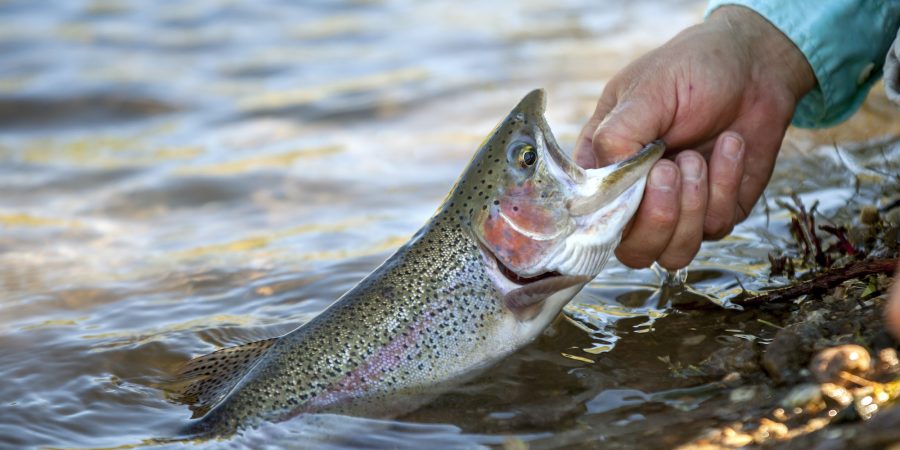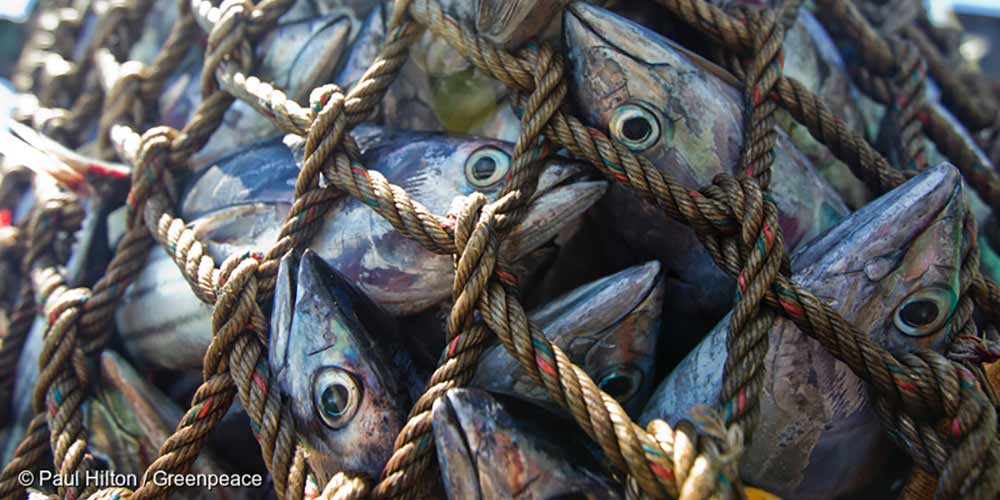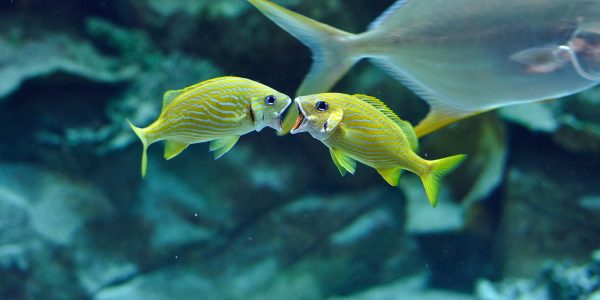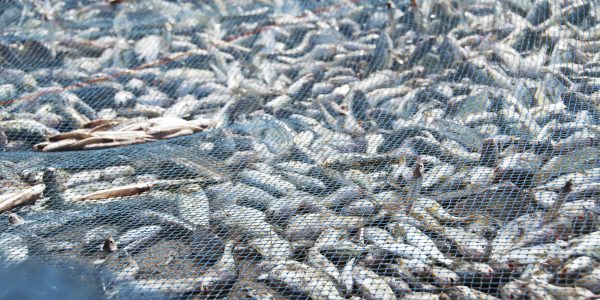Discover more about fish and crustaceans with this in-depth fact sheet.
Fish feel pain
As fish can’t show their pain in a way we recognise, how can we know whether they feel pain at all? There is very strong scientific evidence to show that they do.
Fish have nerve structures which are anatomically similar to those of humans and other mammals. We all have receptor cells (called nociceptors) throughout our bodies which are activated by stimuli which may potentially cause damage to body tissues. Interestingly the lips and mouth of fish are particularly well supplied with these pain specific nerve endings.
As in mammals the nociceptors are linked by nerve fibres to the central nervous system, consisting of the spinal cord and brain. It is activation of the pain centres in the brain which allow animals, and us, to vocalise and respond to potentially damaging or life threatening events. It is obvious that all creatures have evolved ways of maintaining the integrity of their bodies – hence the evolution of that very unpleasant and sometimes persistent state we recognise as pain. The building blocks of pain pathways, including nerves, chemical neurotransmitters and brain centres are similar across a wide range of species, including fish.
The success of “pain” as a protective mechanism is demonstrated by its universality across the vertebrate kingdom. For example fish have evolved the same pain-blocking substances, endorphins, as humans. Endorphins can be thought of as naturally occurring morphine and their role in the body is complex. In species such as fish they may help the animals to tolerate pain from severe injuries to facilitate a successful escape from a predator. As one might now expect, analgesic drugs which are active in humans also appear to reduce pain in fish.
Since fish have the same nerve endings and the same chemicals for transmitting and blocking pain and a brain structure which allows processing of pain signals, it is beyond doubt that fish feel pain.
An example of behavioural indications of pain was a study which injected irritant chemicals into the lips of fish. The fish displayed increased respiratory rate, avoidance of hard pelleted food, rocking behaviour and rubbed their lips on gravel and the tank walls. When morphine was administered to the fish, the incidence of these behaviours was reduced.
This image contains content which some may find confronting

And other suffering?
In addition to the perception of pain, research indicates that fish also have a level of conscious awareness. Certainly it appears fish learn to avoid painful stimuli. For example, carp have been reported to alter their feeding and nesting behaviour following hooking, and some reports indicate avoidance of hooks thereafter. This indicates they may also experience fear and distress.
And, like other captive animals, fish in large aquaria have been observed showing behaviours that indicate they are adversely affected by a restricted environment. The UK-based Captive Animals Protection Society found fish exhibiting abnormal behaviours in 90% of the aquaria they visited in their study – including abnormal feeding, shelter-seeking, bottom-sitting, head-standing and tail walking. These and other repetitive behaviours observed would be described as stereotypies if observed in other animals, a classic sign of stress and neurological dysfunction.
A specialist in fish behaviour from Macquarie University (NSW), Dr Culum Brown stated ‘Fish are more intelligent than they appear. In many areas, such as memory, their cognitive powers match or exceed those of ‘higher’ vertebrates including non-human primates’. Brown’s studies suggest that older fish teach younger fish about predators, for example, including the sound of trawler engines. (From an article ‘Aquatic neurotic: do fish have feelings?’ The Age 23/6/07)
Not surprisingly, some researchers are now supporting calls for the development of Codes of Practice to protect fish due to their cognitive abilities and thus their need for greater consideration: As noted by researchers Davie and Kopf (2006) ‘research on the physiology, behaviour, anatomy and cognitive abilities of fish shows that fish possess similar qualities and exhibit responses that are seemingly analogous to other vertebrate species, notably chickens, which are afforded considerable welfare protection.’
How does fishing cause pain?
Hook and line fishing: Piercing of the well innervated mouth of the fish with a sharp hook and the subsequent hauling in of the fish (which can takes minutes or even hours in the case of game fishing) causes pain. Most people remove the hook while the fish is alive. Anyone who has ever had a fish hook stuck in their own flesh needs no convincing that this is extremely painful.
The practice of landing large fish with a gaff hook is a further cause of severe pain. This large hook on a handle rips into the flesh to pull the live fish out of the water.
Commercial fishing: some net fishing also involves large schools of fish being netted and hauled through or up and out of the water. Fish are pressed tightly together and may suffer through fear and physical crushing prior to landing.
Once out of the water, fish suffocate rather like we would do if held underwater. In their death throes fish writhe, gasping and flapping their gills as they desperately try to get oxygen. Anyone who has ever been unable to breathe even for a short time will understand that this is a terrifying experience.
Recreational Fishing
Fishing for recreation, while being one of the most widely practiced “sports” in the world, is also one of the most common forms of cruelty in the world. Such practices would be prosecuted if other species were involved.
The quantity of fish caught by recreational fishermen is immense. In areas of high population the amount of fish caught is comparable to that taken by commercial fishing. For example, in Port Phillip Bay in Victoria, the Victorian Fisheries Research Institute found that amateurs caught about 469 tonnes of fish annually compared with 482 tonnes by professionals.
Catch and return
In a bid to ensure ‘fish stocks’ are not unnecessarily depleted by recreational fishers (as in the commercial fisheries), fishers have been encouraged to return fish that are too small, of a protected species, or that they do not wish to retain to eat. The hooking, landing, and handling of these ‘unwanted’ fish causes further suffering. Severe hooking injuries, exhaustion from the capture, or injuries through handling (particularly disturbance of the protective slime layer) may lead to susceptibility to predators or infection which will later kill the fish.
Surveys and research have been conducted to assess survival rates. This research is likely to underestimate mortality because is cannot assess the mortality in ‘field’ conditions. Some species appear to survive at high rates – i.e. flathead, whilst at least a third of released snapper in NSW were reported to die after capture and release.
The Code for recreational fishing
The whole practice of fishing is being examined in many countries and increasingly will come under closer scrutiny in Australia. In Australia, fishing associations recognised in the mid-1990s that a ‘Code’ was needed and developed “The National Code of Practice for Recreational and Sport Fishing”. Animal welfare groups were not consulted.
The Code addresses four main areas of fishing responsibility. These include looking after fisheries, protecting the environment, treating fish humanely and respecting the rights of others. The Code is not enforceable.
The Code recommends that unwanted or illegal fish should be returned quickly to the water. Incorrect handling damages the fish and reduces the chances of survival after release. Fish “played” for too long will become exhausted and will not recover.
To treat fish ‘humanely’ the Code recommends:
- retrieve fish as quickly as possible;
- ensure that fish are not left to flop or flail around;
- use wet hands and a minimum of handling to ensure that released fish will have a good chance of survival; and
- revive a tired or semi-conscious fish …
- When it has revived, and is able to swim normally, set it free.
It also notes that “good treatment and handling … is also a mark of the respect that fishers have for fish”. To treat fish humanely “dispatch fish immediately with a firm tap on the head with a suitable blunt object or by pithing”.
At the time of research the Code is silent on gaffing hooks, live bait fish, game fishing etc, and it would appear these cruel practices associated with fishing are acceptable under the Code.
Game Fishing
This is another form of recreational fishing where it is the very large ‘game’ fish that are sought such as marlin and tuna, and where this relatively exclusive and expensive ‘sport’ relates to the skill involved in ‘playing’ and ‘landing’ the large fish. This can take many hours in which time the fish will be distressed and become exhausted. [Note the Code is silent on ‘playing fish’, though it notes in relation to returning unwanted fish that ‘an exhausted fish played too long, may not recover’.]
Usually the bait used in game fishing is a smaller live fish. A live small fish is threaded up as bait for larger fish as described here in a fishing magazine – “The needle is passed through the front of the socket of both eyes. The material is then pulled through so that the hook sits on the head of the baitfish”. The moving ‘bait fish’ assists to attract and then hook the larger fish.
Commercial Fishing
Fishing affects more individual aquatic animals than any other human-based animal industry. The number is incalculable as statistics are only kept on the quantity of tones captured and marketed (and excluding ‘bycatch’ – unwanted fish which may also die). In Australia the commercial ‘wild capture’ fisheries seek some 800 different marine and freshwater ‘seafood’ species – under 300 marketing names – for domestic and overseas consumption. They operate in an area – the fishing zone – surrounding Australia of 10.3 million square kilometres, or 1.3 times the size of the Australian land mass.
The method of capture and death or killing will affect the welfare of literally billions of fish and other aquatic animals each year.
Trawling
Trawling is one of the most common methods of commercial fishing in the world. A trawl is a big, heavy, open-mouthed net that is pulled along the sea bed (demersal trawling) or through the water above the seabed (midwater trawling) by heavy boats. Hundreds of different life forms are killed as demersal trawl nets grind over the sandy bottom of the ocean. When deep-water fish in the nets are dragged up from the ocean depths the change in pressure (called barotrauma) causes their eyes to balloon and their swim bladders to burst. Many fish (and other aqautic animals) drown under the weight of all the other fish and creatures including starfish, crabs and shellfish. The unwanted catch is simply thrown back to the sea where many will subsequently die.
Finning
Finning is an horrific practice which involves catching sharks and slicing off their fins. This is to supply the (primarily) Chinese restaurant market for shark fin soup. The sharks, still alive, are thrown back to the water where they then die of shock and drowning. An estimated 100 million sharks are killed this way each year around the world. Lobbying by Australian environment groups has led to a ban on this practice in most state and Commonwealth waters in Australia.
Purse Seine Nets
Purse seine nets form a circle around shoals of fish and scoop them all out of the water. The size of the mesh sometimes allows smaller fish to escape. Unfortunately, as well as fish, this method may also catch other aquatic animals. Changes to the nets over the past decade have led to modification to enable green turtles and dugongs (endangered animals) to escape the nets.
Long Line Fishing
Thousands of baited hooks are attached to lines that can stretch tens of kilometres behind a boat. Some of the hook lines (snoods) which hang from the main line – and may reach to the bottom (demersal longlines) or near the surface (pelagic longlines). This demersal method of fishing can be used over rocky areas which would tear nets. Unfortunately, many sea birds are also killed by the pelagic longlines during this process as they attempt to feed on the caught fish (large tuna and billfish species) and themselves get hooked. The longlines are now usually baited and set at night in an attempt to reduce the number of seabirds killed.
Drift Gill Netting
This is one of the most destructive methods of fishing. It involves the use of a very strong but very fine net made of nylon which is almost invisible in the water. It forms a wall beneath the waters surface to the seabed and catches all the fish over the size of the net spaces (by their gills), dolphins, small whales, seals and sharks that swim into it.
This method is used primarily to catch salmon and tuna fish and all other creatures are therefore discarded. Drift nets can stretch for more than 30 kilometres and cause a great deal of destruction. They sometimes break free during storms and drift around killing sea animals.
Killing captured or hooked fish
Currently the manner of killing fish – those that are landed (on boat or shore) alive – is usually determined based on ‘product quality’ considerations. The fishing industry has become aware that stressful slaughter methods have a significant impact on the quality of the fish flesh – leading to gaping, soft and/or discoloured flesh and a reduction in ‘shelf life’.
Slaughter methods however still vary dependent on the number of fish, their size, and the value they have in the market place. So, for example, sardines which are caught in huge schools will likely suffocate, whilst large highly prized salmon or tuna fish will be killed by a spike into the brain (ike-jime) or pneumatic bolt. Some medium size fish will be placed into an ice slurry onboard boats and, dependent upon the species, may become chilled and unconscious prior to suffocation, whilst others (particularly fish from cold ocean areas) may suffocate over some hours due to the low level of oxygen in the ice tanks.
Collateral damage
Many fishing practices are also responsible for causing pain and injury to a range of non-target animals. This can occur when used fish hooks and fishing line are not disposed of carefully and injure terrestrial or aquatic animals; when netting is dislodged or abandoned, during long line fishing when birds prey on the bait or already hooked fish; or when turtles, marine mammals and non-target fishes are caught in deadly fishing nets. Human rubbish, particularly plastics, can also injure or kill marine animals.
Aquaculture
The raising of fish in ‘fish farms’ falls into two main categories – those kept in sea pens/enclosures) along the coast, and inland fresh water aquaculture in purpose-built ponds. The fish in these ‘farms’ (akin to ‘feedlots’) will be bred and raised using pelleted food. The food is usually made from fishmeal manufactured from otherwise non-commercial fish species, though some research is underway to also use grain crops for aquaculture feed.
Fish welfare issues have been addressed to some extent because they are also recognised as ‘fish quality’ issues by aquaculture operators. More recently they have developed ‘animal welfare guidelines’. The welfare issues identified include –
- Water quality: oxygen levels, salinity, ammonia levels
- Temperature: thermal shock can kill
- Food quality and delivery regime: more aggressive fish can ‘guard’ feed and consume at level that mean other fish starve
- Stocking density: sometimes very high densities can cause stress and subsequent disease or skin abrasions, fin erosion etc.
- Handling: fish may be ‘handled’ (herded, moved through chutes) a number of times to ensure only similar sized fish are held together – causing stress.
- Predation: fish are in high numbers, closer to the surface than may be natural, and so attract birds and seals which may themselves become entangled in netting intended to protect the fish.
- Killing: humane slaughter methods are being developed/adopted by some, including boat mounted apparatus that mechanically stun fish as they swim through a tunnel, prior to slaughter. Some companies also use sedation (with a clove oil derivative Aqui-S) prior to slaughter.
However, apart from guidelines and voluntary Quality Assurance programs, there are no laws or enforcement of the humane treatment and killing of fish in the aquaculture industry.
Live fish in restaurants
The keeping of live fish (and crustacea) in tanks in restaurants causes considerable and ongoing stress for fish. Multiple handling, water quality, noise, light, disturbance and sometimes high stocking densities with other aquatic animals, means that fish are often ill or die before being selected for the ‘fish of the day’. Selected fish may then be killed by inexpert or incompetent kitchen staff (or, usually illegal, the serving of live animals to diners!).
Pet fish – the aquarium trade
Small fish swimming in circles in a small bowl! The people of Rome in Italy now have regulations introduced in 2005 that they must adhere to if they wish to keep gold fish:
- No spherical fish bowls
- No aquaria with curved sides
- No fish tanks less than 30 litres in capacity, and
- No goldfish are permitted to be given away at fairgrounds.
But here in Australia there are no such bans, though some States provide Codes for guidance, and the Pet Industry Association of Australia provides pets shops with a Code.
Fish which are kept as pets or for display may often suffer – particularly as they are often seen as ‘low skill, low input’ pets, and yet owners may be unaware of their sentience and their specific needs.
Aquaria are frequently too small and cause the fish to suffer from stress, usually exhibited through stereotypic behaviour similar to that displayed by mammals kept in small cages or on chains. Barren environments may lead to boredom and lack of stimulation. Poor water quality, particularly in small aquaria, can cause disease, breathing difficulties and death.
Legislation
In each of the states and territories of Australia existing fishing practices are exempt from cruelty provisions of animal welfare legislation.
In South Australia, fish are denied the protection of the Animal Welfare Act through being specifically excluded in the definition of ‘animal‘.
In the other States fish are included in the definition of ‘animal’, but then by various means, fishing practices are specifically made exempt from the cruelty provisions of those Acts. For example, in 1997, the Victorian Prevention of Cruelty to Animals Act was amended to include both fish and live crustacean in the definitions section. However, the Act then states that the cruelty provisions of the Act do not apply to “recreational fishing or angling conducted in accordance with the Fisheries Act 1968.” In effect, this means that fish and crustacea are protected only in the restaurant and live market trades. Similarly, in 1998 the NSW Prevention of Cruelty to Animals Act expanded the definition of ‘animal’ to include crustaceans, but only in the food preparation and restaurant industry.
In Western Australia, when the new Animal Welfare Act was introduced in 2002 (the most ‘modern’ animal welfare Act in Australia) the fishing lobby fought successfully to ensure it did not include protection for fish or crustacea. However, in recognition of the ability of fish to suffer, in April 2003 the WA Fish Resources Management Act was amended to enable it to adopt Regulations to address cruelty and welfare in fish – through punishable offences for causing unnecessary harm through confinement, restraint, lack of food or through ‘malicious’ injury and similar. The Regulations would be enforced by fisheries officers who would be given the power to issue infringement notices or to prosecute. Those regulations have been drafted but have not yet been introduced.
Currently, fisherpeople across Australia are virtually exempted from prosecution, no matter how much suffering they cause to the fish.
Fish constitute the greatest source of confused thinking and inconsistency on earth at the moment with respect to pain. You will get people very excited about dolphins because they are mammals, and about horses and dogs, if they are not treated properly. At the same time you will have fishing competitions on the River Murray at which thousands of people snare fish with hooks and allow them to asphyxiate on the banks, which is a fairly uncomfortable and miserable death.
Crustaceans
Crustaceans commonly trapped in the food system in Australia include lobsters, crabs, yabbies, marron, crayfish and Balmain bugs. Until recently, there has been no acknowledgement that crustacea are capable of feeling pain and distress, nor has there been any concern for their welfare.
Although they are invertebrate and therefore so different from ourselves that many people have no natural sympathy for them, examination of their nervous systems shows that, in this respect, they are more similar to us than we might think. The sensory systems of lobsters and crabs are highly developed and crustacea make immediate responses to aversive stimuli. Anyone who has witnessed crustacea being boiled alive will be aware of the violent thrashing of these creatures.
Guidelines have now been created to ensure that their treatment and slaughter is as humane as possible. For example, severing the tails from live lobsters and immersing live crustaceans in boiling water is no longer acceptable.
Transportation and Housing
Sources of stress during housing include:
- poor water temperature control
- inadequate aeration
- poor or unsuitable water quality
- overcrowding
- incompatible species kept together
Learn more about marine life
Acknowledgement
Animals Australia gratefully acknowledges the assistance of Dr Suzanne Pope (Animal Liberation SA).







